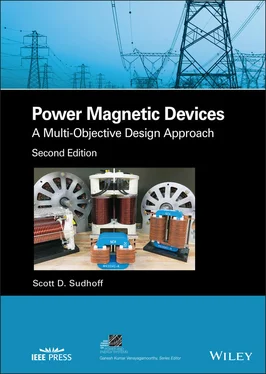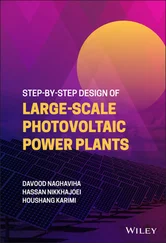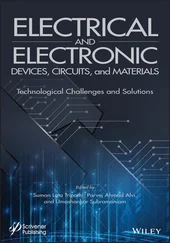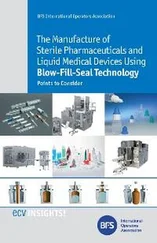Scott D. Sudhoff - Power Magnetic Devices
Здесь есть возможность читать онлайн «Scott D. Sudhoff - Power Magnetic Devices» — ознакомительный отрывок электронной книги совершенно бесплатно, а после прочтения отрывка купить полную версию. В некоторых случаях можно слушать аудио, скачать через торрент в формате fb2 и присутствует краткое содержание. Жанр: unrecognised, на английском языке. Описание произведения, (предисловие) а так же отзывы посетителей доступны на портале библиотеки ЛибКат.
- Название:Power Magnetic Devices
- Автор:
- Жанр:
- Год:неизвестен
- ISBN:нет данных
- Рейтинг книги:4 / 5. Голосов: 1
-
Избранное:Добавить в избранное
- Отзывы:
-
Ваша оценка:
- 80
- 1
- 2
- 3
- 4
- 5
Power Magnetic Devices: краткое содержание, описание и аннотация
Предлагаем к чтению аннотацию, описание, краткое содержание или предисловие (зависит от того, что написал сам автор книги «Power Magnetic Devices»). Если вы не нашли необходимую информацию о книге — напишите в комментариях, мы постараемся отыскать её.
Discover a cutting-edge discussion of the design process for power magnetic devices Power Magnetic Devices: A Multi-Objective Design Approach
Power Magnetic Devices
Power Magnetic Devices — читать онлайн ознакомительный отрывок
Ниже представлен текст книги, разбитый по страницам. Система сохранения места последней прочитанной страницы, позволяет с удобством читать онлайн бесплатно книгу «Power Magnetic Devices», без необходимости каждый раз заново искать на чём Вы остановились. Поставьте закладку, и сможете в любой момент перейти на страницу, на которой закончили чтение.
Интервал:
Закладка:
Table of Contents
1 Cover
2 Series Page IEEE Press 445 Hoes Lane Piscataway, NJ 08854 IEEE Press Editorial Board Ekram Hossain, Editor in Chief Jón Atli Benediktsson Xiaoou Li Jeffrey Reed Anjan Bose Lian Yong Diomidis Spinellis David Alan GrierElya B. Joffe Andreas MolischSaeid Nahavandi Sarah SpurgeonAhmet Murat Tekalp
3 Title Page
4 Copyright Page
5 Dedication Page
6 Author Biography
7 Preface
8 About the Companion Site
9 1 Optimization‐Based Design 1.1 Design Approach 1.2 Mathematical Properties of Objective Functions 1.3 Single‐Objective Optimization Using Newton’s Method 1.4 Genetic Algorithms: Review of Biological Genetics 1.5 The Canonical Genetic Algorithm 1.6 Real‐Coded Genetic Algorithms 1.7 Multi‐Objective Optimization and the Pareto‐Optimal Front 1.8 Multi‐Objective Optimization Using Genetic Algorithms 1.9 Formulation of Fitness Functions for Design Problems 1.10 A Design Example References Problems
10 2 Magnetics and Magnetic Equivalent Circuits 2.1 Ampere’s Law, Magnetomotive Force, and Kirchhoff’s MMF Law for Magnetic Circuits 2.2 Magnetic Flux, Gauss’s Law, and Kirchhoff’s Flux Law for Magnetic Circuits 2.3 Magnetically Conductive Materials and Ohm’s Law For Magnetic Circuits 2.4 Construction of the Magnetic Equivalent Circuit 2.5 Translation of Magnetic Circuits to Electric Circuits: Flux Linkage and Inductance 2.6 Representing Fringing Flux in Magnetic Circuits 2.7 Representing Leakage Flux in Magnetic Circuits 2.8 Numerical Solution of Nonlinear Magnetic Circuits 2.9 Permanent Magnet Materials and Their Magnetic Circuit Representation 2.10 Closing Remarks References Problems
11 3 Introduction to Inductor Design 3.1 Common Inductor Architectures 3.2 DC Coil Resistance 3.3 DC Inductor Design 3.4 Case Study 3.5 Closing Remarks References Problems
12 4 Force and Torque 4.1 Energy Storage in Electromechanical Devices 4.2 Calculation of Field Energy 4.3 Force from Field Energy 4.4 Co‐Energy 4.5 Force from Co‐Energy 4.6 Conditions for Conservative Fields 4.7 Magnetically Linear Systems 4.8 Torque 4.9 Calculating Force Using Magnetic Equivalent Circuits References Problems
13 5 Introduction to Electromagnet Design 5.1 Common Electromagnet Architectures 5.2 Magnetic, Electric, and Force Analysis of an Ei‐Core Electromagnet 5.3 EI‐Core Electromagnet Design 5.4 Case Study References Problems
14 6 Magnetic Core Loss and Material Characterization 6.1 Eddy Current Losses 6.2 Hysteresis Loss and the B – H Loop 6.3 Empirical Modeling of Core Loss 6.4 Magnetic Material Characterization 6.5 Measuring Anhysteretic Behavior 6.6 Characterizing Behavioral Loss Models 6.7 Time‐Domain Loss Modeling: the Preisach Model 6.8 Time‐Domain Loss Modeling: the Extended Jiles–Atherton Model References Problems
15 7 Transformer Design 7.1 Common Transformer Architectures 7.2 T‐Equivalent Circuit Model 7.3 Steady‐State Analysis 7.4 Transformer Performance Considerations 7.5 Core‐Type Transformer Configuration 7.6 Core‐Type Transformer MEC 7.7 Core Loss 7.8 Core‐Type Transformer Design 7.9 Case Study 7.10 Closing Remarks References Problems
16 8 Distributed Windings and Rotating Electric Machinery 8.1 Describing Distributed Windings 8.2 Winding Functions 8.3 Air‐Gap Magneto Motive Force 8.4 Rotating MMF 8.5 Flux Linkage and Inductance 8.6 Slot Effects and Carter’s Coefficient 8.7 Leakage Inductance 8.8 Resistance 8.9 Introduction to Reference Frame Theory 8.10 Expressions for Torque References Problems
17 9 Introduction to Permanent Magnet AC Machine Design 9.1 Permanent Magnet Synchronous Machines 9.2 Operating Characteristics of PMAC Machines 9.3 Machine Geometry 9.4 Stator Winding 9.5 Material Parameters 9.6 Stator Currents and Control Philosophy 9.7 Radial Field Analysis 9.8 Lumped Parameters 9.9 Ferromagnetic Field Analysis 9.10 Formulation of Design Problem 9.11 Case Study 9.12 Extensions References Problems
18 10 Introduction to Thermal Equivalent Circuits 10.1 Heat Energy, Heat Flow, and the Heat Equation 10.2 Thermal Equivalent Circuit of One‐Dimensional Heat Flow 10.3 Thermal Equivalent Circuit of a Cuboidal Region 10.4 Thermal Equivalent Circuit of a Cylindrical Region 10.5 Inhomogeneous Regions 10.6 Material Boundaries 10.7 Thermal Equivalent Circuit Networks 10.8 Case Study: Thermal Model of Electromagnet References Problems
19 11 Alternating Current Conductor Losses 11.1 Skin Effect in Strip Conductors 11.2 Skin Effect in Cylindrical Conductors 11.3 Proximity Effect in a Single Conductor 11.4 Independence of Skin and Proximity Effects 11.5 Proximity Effect in a Group of Conductors 11.6 Relating Mean‐Squared Field and Leakage Permeance 11.7 Mean‐Squared Field for Select Geometries 11.8 Conductor Losses in Rotating Machinery 11.9 Conductor Losses in a UI‐Core Inductor 11.10 Closing Remarks References Problems
20 12 Parasitic Capacitance 12.1 Modeling Approach 12.2 Review of Electrostatics 12.3 Turn‐to‐Turn Capacitance 12.4 Coil‐to‐Core Capacitance 12.5 Layer‐to‐Layer Capacitance 12.6 Capacitance in Multi‐Winding Systems 12.7 Measuring Capacitance References Problems
21 13 Buck Converter Design 13.1 Buck Converter Analysis 13.2 Semiconductors 13.3 Heat Sink 13.4 Capacitors 13.5 UI‐Core Input Inductor 13.6 UI‐Core Output Inductor 13.7 Operating Point Analysis 13.8 Design Paradigm 13.9 Case Study 13.10 Extensions References Problems
22 14 Three‐Phase Inductor Design 14.1 System Description 14.2 Inductor Geometry 14.3 Magnetic Equivalent Circuit 14.4 Magnetic Analysis 14.5 Inductor Design Paradigm 14.6 Case Study References Problems
23 15 Common‐Mode Inductor Design 15.1 Common‐Mode Voltage and Current 15.2 System Description 15.3 Common‐Mode Equivalent Circuit 15.4 Common‐Mode Inductor Specification 15.5 UR‐Core Common‐Mode Inductor 15.6 UR‐Core Common‐Mode Inductor Magnetic Analysis 15.7 Common‐Mode Inductor Design Paradigm Constraints 15.8 Common‐Mode Inductor Case Study References Problems
24 16 Finite Element Analysis 16.1 Maxwell’s and Poisson’s Equations 16.2 Finite Element Analysis Formulation 16.3 Finite Element Analysis Implementation 16.4 Closing Remarks References Problems
25 Appendix A: Conductor Data and Wire Gauges References
26 Appendix B: Selected Ferrimagnetic Core Data Reference
27 Appendix C: Selected Magnetic Steel Data Reference
28 Appendix D: Selected Permanent Magnet Data Reference
29 Appendix E: Phasor Analysis
30 Appendix F: Trigonometric Identities
31 Index
32 Books in the IEEE Press Series on Power and Energy Systems
33 End User License Agreement
List of Tables
1 Chapter 1 Table 1.1 Newton’s Method Results Table 1.2 Pseudo‐Code for Mating, Crossover, Segregation, and Mutation Table 1.3 Example of Real‐Coded Genetic Algorithm Evolution Table 1.4 Linear Scaling Methods Table 1.5 Pseudo‐Code for Kung’s Method Table 1.6 Approach for Treating Constraints Table 1.7 Domain of Design Parameters
2 Chapter 2 Table 2.1 Permeability Function Parameters Table 2.2 Nodal Analysis Formulation Algorithm (NAFA) Table 2.3 Branch List for Nodal Analysis Table 2.4 Mesh Analysis Formulation Algorithm (MAFA) Table 2.5 Branch List for Mesh Analysis Table 2.6 Nonlinear MEC Solution AlgorithmTable 2.7 Selected Permanent Magnet Properties
3 Chapter 3Table 3.1 Calculation of Fitness FunctionTable 3.2 Inductor SpecificationsTable 3.3 Design SpaceTable 3.4 Design 50 Data
4 Chapter 5Table 5.1 Calculation of Fitness FunctionTable 5.2 Electromagnet SpecificationsTable 5.3 Design SpaceTable 5.4 Design 250 Data
5 Chapter 6Table 6.1 Aluminum Alloy Test Samples
6 Chapter 7Table 7.1 Core and Clearance DimensionsTable 7.2 Winding ParametersTable 7.3 Pseudo‐code for Calculation of the Fitness FunctionTable 7.4 Pseudo‐code for Check of Constraints Satisfied Against ImposedTable 7.5 Transformer SpecificationsTable 7.6 Transformer Fixed ParametersTable 7.7 Design SpaceTable 7.8 Design 100 ParametersTable 7.9 Electrical ParametersTable 7.10 Operating Point Performance
Читать дальшеИнтервал:
Закладка:
Похожие книги на «Power Magnetic Devices»
Представляем Вашему вниманию похожие книги на «Power Magnetic Devices» списком для выбора. Мы отобрали схожую по названию и смыслу литературу в надежде предоставить читателям больше вариантов отыскать новые, интересные, ещё непрочитанные произведения.
Обсуждение, отзывы о книге «Power Magnetic Devices» и просто собственные мнения читателей. Оставьте ваши комментарии, напишите, что Вы думаете о произведении, его смысле или главных героях. Укажите что конкретно понравилось, а что нет, и почему Вы так считаете.












